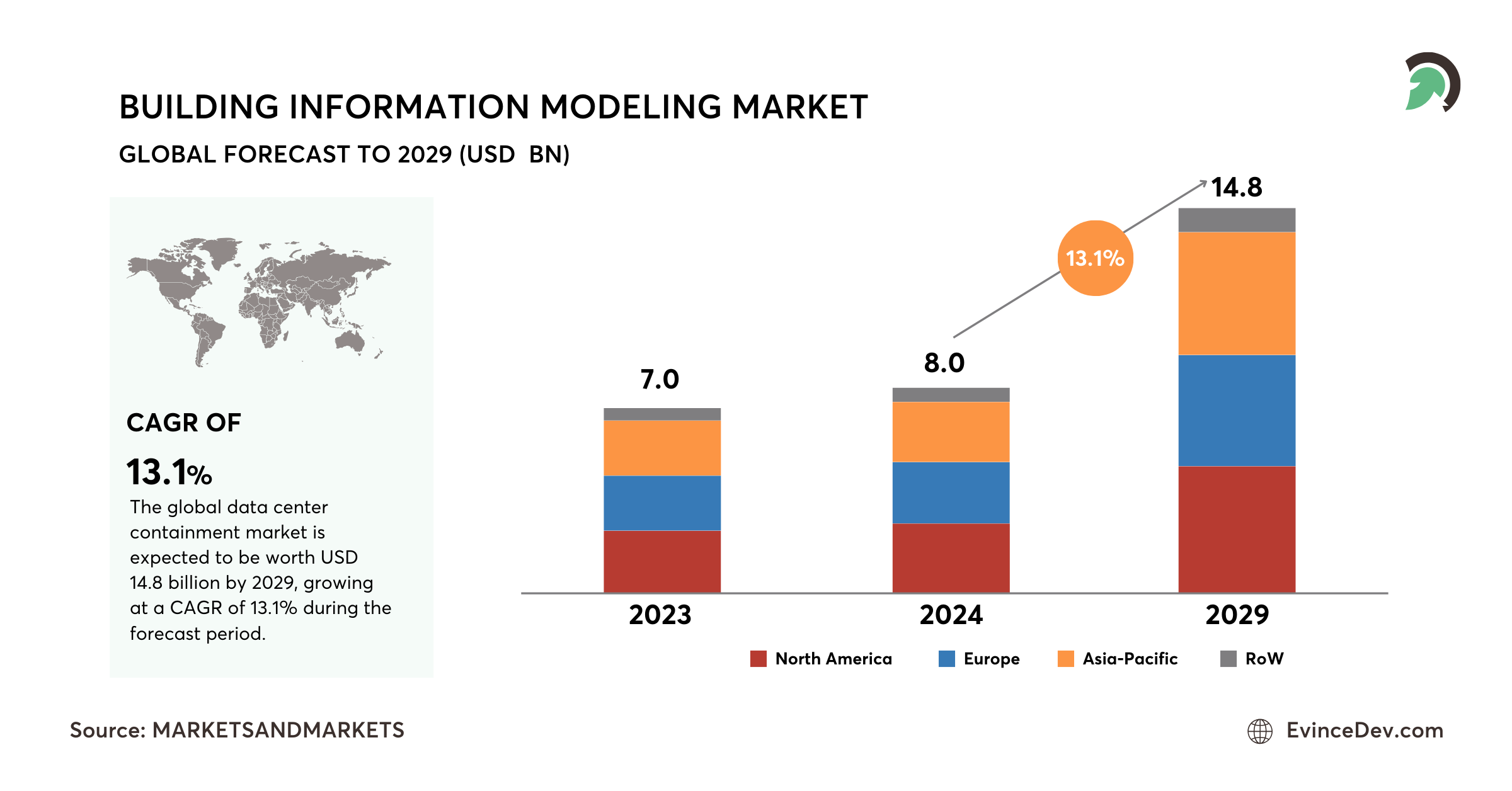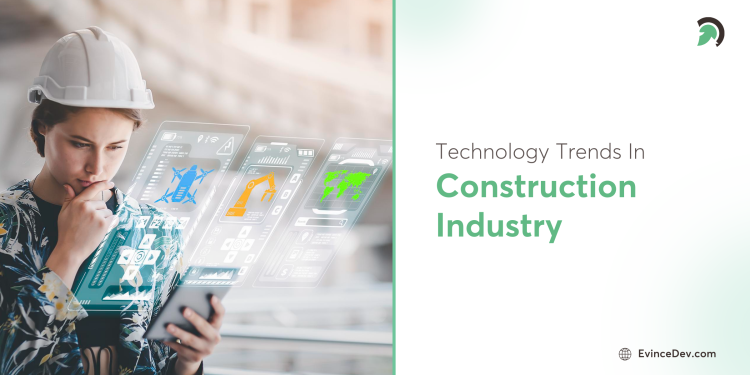The construction industry embraces a new wave of innovation, leveraging advanced technologies to improve efficiency, safety, and sustainability. Latest technology trends are transforming how projects are designed, managed, and executed, making it crucial for stakeholders to stay ahead of emerging trends. With the rise of construction software development, companies are adopting smarter, faster, and more cost-effective solutions that streamline operations and enhance decision-making.
This blog will explore ten transformative construction technology trends expected to dominate in 2026. They are reshaping the construction landscape from automation and drones to AI and digital twins. Understanding their potential applications and benefits can help contractors, developers, and builders future-proof their businesses.
- The global construction market, estimated at USD 10.43 trillion in 2023, is expected to surge to USD 16.10 trillion by 2030, achieving a 5.9% CAGR from 2024 to 2030.
1. Building Information Modeling (BIM)
Building Information Modeling (BIM) has been a cornerstone of digital transformation in construction, and its evolution continues to shape the industry. BIM provides a collaborative platform that enables all stakeholders to work on a unified project model. By integrating dimensions like time (4D) and cost (5D), BIM helps construction teams simulate schedules, forecast expenses, and minimize errors before construction begins. As regulations around digital construction increase, BIM adoption is becoming essential.
Projected to grow at a CAGR of 13.1% from 2024 to 2029, the Building Information Modeling market is set to rise from USD 8.0 billion to an impressive USD 14.8 billion by the end of 2029.

BIM is widely used in urban infrastructure projects, commercial developments, and real estate. Integrating BIM with IoT and AI further enhances its capabilities, making it a powerful tool for managing complex construction workflows.
2. Artificial Intelligence and Machine Learning
Artificial Intelligence (AI) and Machine Learning (ML) drive significant advancements in construction planning, resource optimization, and safety. AI systems analyze massive datasets to predict delays, improve risk management, and streamline workflows. For example, ML algorithms can identify equipment maintenance needs before failures occur, saving costs and reducing downtime. AI also enhances worker safety by detecting potential hazards and optimizing site layouts.
Large-scale projects benefit the most from AI and ML as it simplify decision-making and improve efficiency. By automating repetitive tasks like scheduling and cost estimation, AI empowers construction teams to focus on strategic planning.
3. Internet of Things (IoT)
The Internet of Things (IoT) is revolutionizing construction by creating connected ecosystems on job sites. IoT sensors monitor machinery performance, track environmental conditions, and ensure worker safety in real-time. For example, sensors can alert managers to equipment issues before they escalate, reducing downtime and maintenance costs. Additionally, IoT systems improve site safety by tracking worker movements and detecting hazardous conditions.
IoT is widely implemented in smart city construction, urban developments, and large-scale infrastructure projects. Integrating with technologies like BIM and AI enhances data-driven decision-making and operational efficiency.
4. Digital Twins
Digital Twin technology creates virtual replicas of physical assets, enabling real-time monitoring and predictive analysis. It integrates data from IoT devices, drones, and BIM systems to provide actionable insights for construction teams. By simulating scenarios and predicting outcomes, digital twins optimize resource allocation, reduce risks, and enhance project planning.
They are instrumental in infrastructure development and smart city projects, where accuracy and efficiency are paramount. They enable proactive maintenance and real-time adjustments, ensuring projects stay on track.
5. 4D Simulation
4D simulation revolutionizes construction project management by integrating time (the fourth dimension) into 3D models. This technology enables construction teams to visualize the progression of a project over time, providing a dynamic representation of the construction process. By linking the construction schedule to the 3D model, stakeholders can identify potential delays, optimize resource allocation, and improve decision-making.
4D simulation benefits complex projects like infrastructure development, where accurate timelines and seamless coordination are crucial for success.
6. Drones for Site Monitoring
Drones have become indispensable tools for construction site monitoring, offering high-resolution visuals and real-time data. Unmanned aerial vehicles (UAVs) are used for site surveys, inspections, and progress tracking. By capturing aerial images and videos, drones provide accurate 3D models of construction sites, helping teams identify potential risks and allocate resources efficiently. Additionally, drones improve worker safety by inspecting hazardous or hard-to-reach areas.
Drones are instrumental in infrastructure development, large residential projects, and commercial construction. Their ability to speed up inspections and deliver precise data makes them a must-have for modern construction companies.
7. Construction Robots and Automation
The rise of automation in construction is solving labor shortages and boosting productivity. Robots now perform tasks like bricklaying, welding, and painting with unmatched precision. On-site 3D printing is another breakthrough, enabling the rapid fabrication of building components. It not only accelerates project timelines but also ensures consistent quality.
Construction robots are particularly valuable in industrial and commercial projects, where efficiency and precision are critical. By automating repetitive tasks, companies can reduce costs, enhance safety, and improve project outcomes.
8. Virtual Reality (VR) and Augmented Reality (AR)
Virtual Reality (VR) and Augmented Reality (AR) transform how construction projects are planned and executed. VR immerses stakeholders in a virtual environment, allowing them to explore a building’s design and functionality before construction begins. AR overlays digital elements onto real-world environments, aiding on-site planning and measurements. It improves collaboration, reduces errors, and enhances stakeholder communication.
VR and AR are particularly beneficial in real estate software development, where immersive experiences can help clients visualize spaces and make informed decisions. It saves time and costs by reducing rework and improving design accuracy.
9. Modular Construction and Prefabrication
Modular construction and prefabrication are transforming how buildings are designed and assembled. This approach involves building components off-site in controlled environments before transporting and assembling them on-site. Modular construction reduces waste, shortens project timelines, and lowers costs by streamlining the building process.
It is particularly beneficial in residential developments, healthcare facilities, and temporary structures. With the support of advanced construction software, companies can ensure seamless integration of prefabricated components into their projects.
10. Advanced Construction Materials
The development of advanced materials is enhancing construction efficiency and sustainability. Materials like self-healing concrete, translucent wood, and graphene-reinforced composites revolutionize building design and maintenance. Self-healing concrete, for example, uses bacteria to repair cracks, extending the lifespan of structures and reducing maintenance costs. Similarly, lightweight composites improve energy efficiency while maintaining structural integrity.
11. Sustainable Construction Technologies
Sustainability is a growing focus in the construction industry, with new technologies enabling eco-friendly practices. From energy-efficient materials to renewable energy systems, it reduces environmental impact and promotes green building standards. Advanced construction software tracks carbon emissions, monitors energy consumption, and manages waste, helping companies achieve sustainability goals.
Sustainable technologies are widely adopted in residential and urban developments. Companies prioritizing green practices benefit from reduced operational costs, improved compliance with regulations, and enhanced market appeal.
It is adopted in high-performance buildings, infrastructure projects, and green construction. By incorporating advanced materials, companies can deliver innovative solutions that meet modern demands.
Why Custom Construction Software Development Matters
EvinceDev for Future-Ready Solutions
From digital twins to sustainable construction technologies, the trends outlined in this blog are revolutionizing the construction industry. Staying ahead requires adopting the latest innovations and having the right partner to navigate this transformation. EvinceDev, a leading software development company in the USA, offers expertise in developing solutions that empower construction firms to work smarter and achieve lasting success.
Take the first step towards innovation with EvinceDev’s Free Consultation to explore how it can transform your business. In the rapidly evolving construction landscape, investing in advanced technologies today ensures your company is equipped to excel in 2026 and beyond. Trust EvinceDev to deliver future-ready solutions tailored to your needs.








